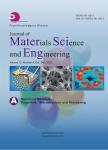Effect of Photoanode Modification on Charge Transport,Recombination and Efficiency of Dye Sensitized SolarCells Using Synthetic Organic Dyes
作者机构:Department of PhysicsUniversity of MandalayMandalay 05032Myanmar Department of PhysicsMandalar Degree CollegeMandalay 05061Myanmar Universities’Research CentreUniversity of YangonYangon 11041Myanmar
出 版 物:《材料科学与工程(中英文A版)》 (Journal of Materials Science and Engineering A)
年 卷 期:2020年第10卷第1期
页 面:30-36页
基 金:Authors acknowledge the project grant(Activity code:MYA-01 2017-2019)from International Science Program(ISP) Uppsala University Sweden
主 题:DSSCs LEG4 dye TiO2 photoanode charge transport recombination
摘 要:The DSSCs (Dye-sensitized solar cells) with photoanode using different sizes of particulate TiO2 (18 nm, 30 nm and 200 nm) have been fabricated. The synthetic organic dyes (LEG4) was used as photosensitizer. The present work mainly investigates the influence of TiO2 photoanode modification on light absorption, charge transport and carrier recombination which are then correlated to the device efficiency measured under AM1.5 solar irradiance. The DSSCs with photoanode using larger 200-nm-TiO2 as light scatterer outperform other devices without larger TiO2. It is attributed to an increase in harvesting photons (by UV-vis spectroscopic measurement) via light scattering, smaller ideality factor (by dark current analysis), thus lower recombination possibility, lower charge transfer resistance and longer electron lifetime (by electrochemical impedance spectroscopy) which results in longer electron diffusion and higher charge collection efficiency. The photoanode modification in DSSCs has a strong impact on optical and charge transport properties, and eventually on the photovoltaic performance.



